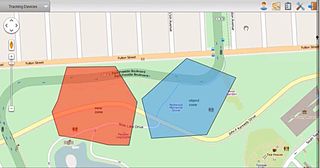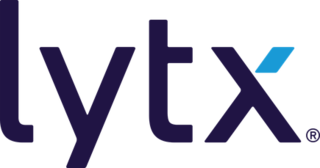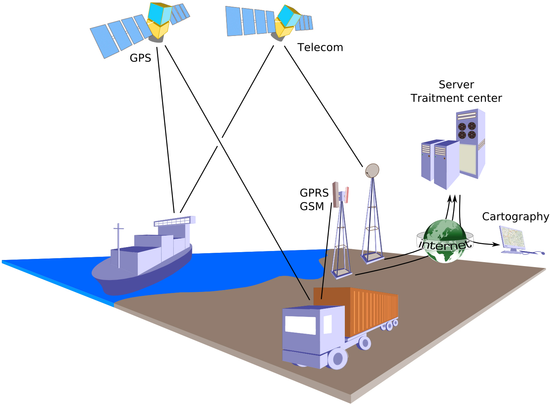
Telemetry is the in situ collection of measurements or other data at remote points and their automatic transmission to receiving equipment (telecommunication) for monitoring. The word is derived from the Greek roots tele, 'remote', and metron, 'measure'. Systems that need external instructions and data to operate require the counterpart of telemetry: telecommand.
Automatic vehicle location is a means for automatically determining and transmitting the geographic location of a vehicle. This vehicle location data, from one or more vehicles, may then be collected by a vehicle tracking system to manage an overview of vehicle travel. As of 2017, GPS technology has reached the point of having the transmitting device be smaller than the size of a human thumb, able to run 6 months or more between battery charges, easy to communicate with smartphones — all for less than $20 USD.

Telematics is an interdisciplinary field encompassing telecommunications, vehicular technologies, electrical engineering, and computer science. Telematics can involve any of the following:

OnStar Corporation is a subsidiary of General Motors that provides subscription-based communications, in-vehicle security, emergency services, turn-by-turn navigation, and remote diagnostics systems throughout the United States, Canada, Chile, China, Mexico, Europe, Brazil, Colombia, Argentina and the Gulf Cooperation Council countries.

A tracking system, also known as a locating system, is used for the observing of persons or objects on the move and supplying a timely ordered sequence of location data for further processing.
Machine to machine (M2M) is direct communication between devices using any communications channel, including wired and wireless. Machine to machine communication can include industrial instrumentation, enabling a sensor or meter to communicate the information it records to application software that can use it. Such communication was originally accomplished by having a remote network of machines relay information back to a central hub for analysis, which would then be rerouted into a system like a personal computer.
A GPS tracking unit, geotracking unit, satellite tracking unit, or simply tracker is a navigation device normally on a vehicle, asset, person or animal that uses satellite navigation to determine its movement and determine its WGS84 UTM geographic position (geotracking) to determine its location. Satellite tracking devices may send special satellite signals that are processed by a receiver.
Fleet management software (FMS) is computer software that enables people to accomplish a series of specific tasks in the management of any or all aspects relating to a fleet of vehicles operated by a company, government, or other organisation. These specific tasks encompass all operations from vehicle acquisition through maintenance to disposal.
A Fleet Telematics System (FTS) allows the information exchange between a commercial vehicle fleet and their central authority, i.e., the dispatching office. A FTS typically consists of mobile Vehicle Systems (VS) and a stationary Fleet Communication System (FCS). The FCS may be a stand-alone application maintained by the motor carrier or an internet service running by the supplier of the system. The FCS usually includes a database in which all vehicle positions and messages are stored.

Telogis was a privately held US-based company that develops location-based software to manage mobile resources. Telogis sold software as a service (SaaS) which incorporated location information into applications for fleet owners as well as geospatial software development toolkits.

A geofence is a virtual perimeter for a real-world geographic area. A geofence can be dynamically generated or match a predefined set of boundaries.
Fleet Controlling is a platform of telematic systems for wagon-vehicle and mobile equipment that allows service for back-office management in any company. Depending on supplier officers take advantages of:
A vehicle tracking system combines the use of automatic vehicle location in individual vehicles with software that collects these fleet data for a comprehensive picture of vehicle locations. Modern vehicle tracking systems commonly use GPS or GLONASS technology for locating the vehicle, but other types of automatic vehicle location technology can also be used. Vehicle information can be viewed on electronic maps via the Internet or specialized software. Urban public transit authorities are an increasingly common user of vehicle tracking systems, particularly in large cities.
A connected car is a car that can communicate bidirectionally with other systems outside of the car. This connectivity can be used to provide services to passengers or to support or enhance self-driving functionality. For safety-critical applications, it is anticipated that cars will also be connected using dedicated short-range communications (DSRC) or cellular radios, operating in the FCC-granted 5.9 GHz band with very low latency.

Lytx is a San Diego, California based technology company that designs, manufactures and sells video telematics products used by commercial and public-sector fleets to help improve driver safety and business productivity. Products include risk detection, fleet tracking, and driver safety programs that use artificial intelligence and analysts to identify risky driving behaviors and report real-time fleet information. The company's clients include waste management and sanitation companies, trucking and distribution, government and municipality vehicles, passenger transit, construction, utilities, telecom and field services. Lytx also provides compliance services for trucking fleets regulated by the U.S. Department of Transportation.

Masternaut Limited is a telematics company specialising in fleet and asset management. They achieved initial recognition with Martin Port as CEO and subsequently with Martin Hiscox as Chairman were featured as a 2015 UK Government Future 50 Tech Company and in the Sunday Times Tech Track 100, a list of the fastest growing UK technology firms, in 2007, 2008, 2009, 2010 and 2014. In April 2011 Masternaut merged with former AIM-listed competitor Cybit, and is operating under the Masternaut name. The company is owned by Summit Partners and Fleetcor, following its acquisition from Francisco Partners in 2014. and are now owned by Michelin. Masternaut has around 400 employees, based in the UK and France.
ERM Electronic Systems ltd., also known as ERM Advanced Telematics, is an Israeli electronic company specializing in the design, development, and manufacture of vehicle security and GPS tracking devices for the telematics and fleet management industry. ERM Advanced Telematics operates globally, providing telematics devices for Stolen Vehicle Recovery (SVR) and Fleet Management Solutions (FMS), all seamlessly integrated within vehicle security.
Geotab Inc. is a Canadian technology company headquartered in Oakville, Ontario. The company develops and markets telematics hardware and software for use with motor vehicles. The company's products are primarily used for fleet management, including on-board diagnostics, electronic logging, route optimization, accident data recording and CO2 emissions reporting.

Airbiquity Inc. was a business-to-business (B2B) software development and engineering company operating in the automotive telematics industry. Airbiquity's business model was to develop, deploy, and support the ongoing management of connected car programs for automotive industry customers.
US Fleet Tracking is a privately owned company that specializes in manufacturing and distributing GPS Tracking products and accessories designed to enable businesses and individuals to monitor their mobile assets and vehicle fleets, tracking those vehicles live, in realtime, as they move.








